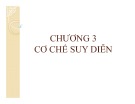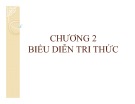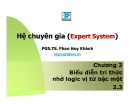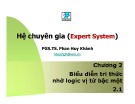
2/
2/68
68
Chương
Chương 2
2
Bi
Biể
ểu di
u diễ
ễn tri th
n tri thứ
ức nh
c nhờ
ờ
logic v
logic vị
ị
t
từ
ừ
b
bậ
ậc m
c mộ
ột
t
a
aPh
Phầ
ần 2.2 :
n 2.2 :
V
VKh
Khá
ái ni
i niệ
ệm lôgic
m lôgic
V
VLôgic m
Lôgic mệ
ệnh đ
nh đề
ề

3/
3/68
68
The 4 Color Theorem
The 4 Color Theorem
a
aIn 1879,
In 1879, Kempe
Kempe produced a famous proof of the 4 color
produced a famous proof of the 4 color
theorem:
theorem:
V
VUsing only 4 colors
Using only 4 colors
V
VAny
Any map of countries can be colored in such a way that
map of countries can be colored in such a way that
no 2 bordering countries have the same
no 2 bordering countries have the same color
color
a
aIn
In 1890,
1890, Heawood
Heawood showed:
showed:
V
VThe
The proof not to be a proof at all!
proof not to be a proof at all!
a
aWhen is a proof a proof, and when is it not a proof?
When is a proof a proof, and when is it not a proof?
a
aLogic to the rescue!
Logic to the rescue!

4/
4/68
68
What is the logic?
What is the logic?
a
aLogic is the science of
Logic is the science of reasoning
reasoning,
, proof
proof,
, thinking
thinking,
,
or
or inference
inference
a
aLogic allows us to analyze a piece of reasoning
Logic allows us to analyze a piece of reasoning
and determine whether it is correct or not
and determine whether it is correct or not
a
aTo use the technical terms, we determine whether
To use the technical terms, we determine whether
the reasoning is
the reasoning is valid
valid or
or invalid
invalid
a
aWhen people talk of
When people talk of logical
logical arguments
arguments, though,
, though,
they generally mean the type being described here
they generally mean the type being described here

5/
5/68
68
Logic
Logic
a
aLogic is the study of reasoning
Logic is the study of reasoning
a
aIn
In particular:
particular:
V
VLogic
Logic studies the conditions under which we can say that a
studies the conditions under which we can say that a
piece of reasoning is
piece of reasoning is
valid
valid
V
VI.e
I.e. that something (the conclusion) can be said to
. that something (the conclusion) can be said to
follow
follow
from
from
something else (the premises, givens,
something else (the premises, givens, assumptions)
assumptions)
a
aOntology
Ontology (ont =
(ont = ‘
‘to be
to be’
’; logica =
; logica = ‘
‘word
word’
’):
):
kinds of things one can talk about in the language
kinds of things one can talk about in the language



























